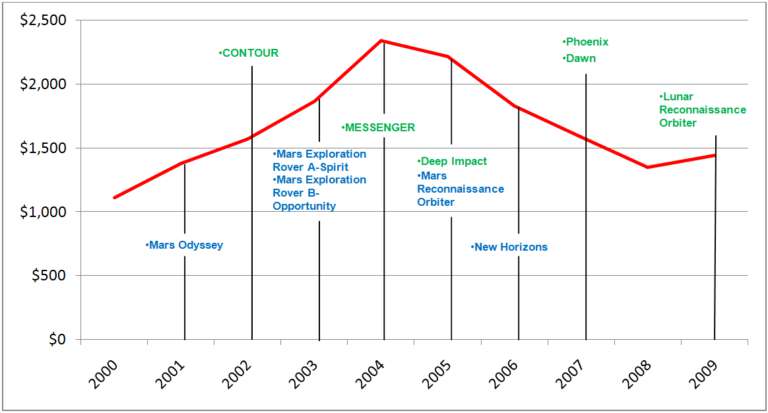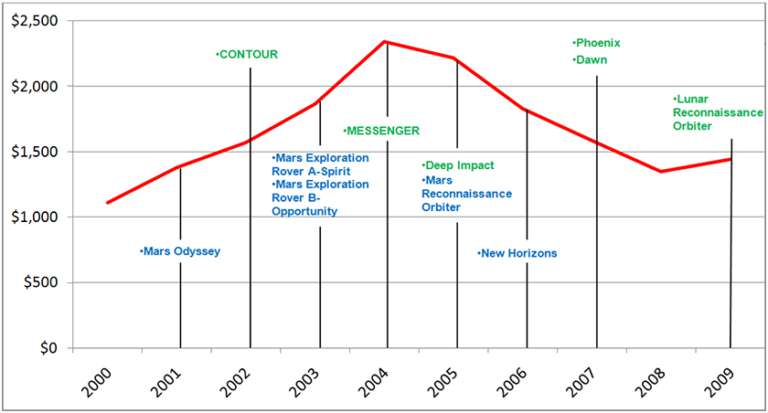Jason Callahan • Sep 11, 2014
Recovery. Peak. Collapse. Planetary Science from 1990 - 2014
Growth, peak, and collapse. This was the story I told in my last post about NASA's planetary exploration program from its birth through the end of the 1980s. This story is echoed in the modern era of planetary science: the 1990s through today.
With the moribund 1980s and the survival crisis behind it, the planetary science program regained confidence and capability in the 1990s. In addition to new money, NASA developed a crucial new approach to ensuring a continuing series of small missions with the Discovery program. The strategy of the program used a competitive selection process that didn’t need congressional approval for individual missions, and it survives to this day.
As a reminder, the plots used throughout this piece show missions color-coded by their cost:
Green = Small mission class (equivalent to Discovery), < $450M including launch vehicle
Blue = Medium mission class (equivalent to New Frontiers), < $1B not including launch vehicle
Red = Flagship mission class, > $1B
The 1990s: Recovery
Recognizing the crisis in their field in the late 1980s, the planetary science community (including those within NASA) increased the call for a sustainable small-class mission program. NASA had attempted several small-class flight strategies in the past, but none lasted more than one or two missions. Following on the success of the astronomy community’s Explorer program, NASA instituted a small mission program for solar system exploration in 1992, called Discovery. You can see the increased number of missions reflected in our plot below.

Discovery managers were able to sustain a steady line of small missions throughout the 1990s and into the 2000s while NASA built and flew the Cassini/Huygens flagship mission—even under a reduced budget. One of the main advantages of a program line like Discovery is that NASA doesn’t have to seek approval from Congress for every new mission start, since Congress has already approved the rules by which NASA will select the missions in that program.

NASA’s Mars program, established with its own budget line in 1993, enjoyed a tremendous amount of positive attention with the Mars Pathfinder mission and the Mars Global Surveyor, but at the end of the decade, NASA lost the Mars Climate Orbiter and the Mars Polar Lander within a month. New program leadership established a strategic plan for Mars exploration, providing a roadmap for future missions. The plan involved building scientific knowledge of evidence for water on Mars systematically and, in tandem with an increased budget, provided NASA with exceptional results, and an unparalleled scientific return in the following decade.
The 2000s: A New Golden Age
The 2000s again saw an increasing budget for planetary science in the early part of the decade to levels the community had never seen before. NASA flew a well-balanced portfolio of missions to new destinations and to revisit places previously explored but driven by new research questions. Even before the global economic downturn in 2008, NASA’s planetary science budget began to erode, but it didn’t collapse to the levels seen after the bubbles of the 1960s and 1970s. I think NASA can attribute much of the sustainability to the success of the Discovery and Mars Exploration programs, and the addition of a medium-class mission program in 2003 called New Frontiers, based on the Discovery model of competed missions.

With the Discovery program, NASA intended to release Announcement of Opportunities for the Principal Investigator-led, small class missions every 12 to 24 months. Since the beginning of the program, NASA has launched a Discovery mission every 1-2 years through 2011 (including the 2009 launch of the Kepler spacecraft, which was developed and launched as a Discovery mission, but moved to the Exoplanet Exploration program at JPL for operations).
The 2010s: A New Decline
Looking at the tentative schedule for NASA’s planetary exploration program for the rest of this decade, we see a definite downward trend in the number of flights planned, which follows just a few years after the downward trend we see in the late-2000s budget.

The three launches in 2011 are the result of the previous decade's strong funding levels. Look at the dropping frequency of new missions. This is due, in large part, to the disproportionate cut to the Planetary Science Division seen in FY2013. Not seen easily in this plot is the additional programmatic requirements placed on the Division around the same time; $70 million for Plutonium-238 infrastructure and production, $40 million for Near Earth Asteroid searches, and the significant ongoing costs of operating last decade's missions. These are all important programs, but the key thing to take away here is that these additional spending requirements were all added while the budget was cut by 20 percent.
With additional programmatic requirements and a dropping budget, new missions were cancelled or delayed. NASA pulled out of a joint Mars mission with the European Space Agency in 2012. And while NASA selected its next Discovery mission in 2012—a Mars lander named InSight—NASA didn't announce the next Discovery mission opportunity until July of 2014, with a final selection by the end of 2015. The mission will not launch before InSight, meaning there will be at least a five-year gap between Discovery mission launches. For the first time in 20 years, the pace of the Discovery program will fall below NASA’s goal.

This is also happening with New Frontiers missions. NASA instituted the New Frontiers program with plans to fund an opportunity for a new, Principal Investigator-led medium class missions every 36 months. NASA selected the first New Frontiers mission in 2001 (New Horizons), the second project in 2005 (Juno), and the third project in 2011 (OSIRIS-REx). NASA’s plans to select a New Frontiers mission every three years fell behind schedule almost immediately. NASA has launched New Frontiers missions every five years since the program’s beginning. But, disconcertingly, the FY2015 NASA budget stated that NASA has no plans for another New Frontiers mission at all.
At the moment, NASA has two missions in active development, InSight and OSIRIS-REx. The Mars 2020 rover is in "formulation" stage (basically detailed engineering planning), and the next Discovery mission will be in a similar stage for years. Since NASA prioritizes projects in development over those in formulation, if the budget were to see further reductions, Mars 2020 and Discovery 2014 face a higher risk of cancellation.
NASA has also spent a limited amount of money on pre-formulation activities for a Europa mission, which has support in Congress. The mission’s future still faces a great deal of uncertainty, with no proposed timeframe as of now. I certainly favor a Europa mission, but I’m wary of a large effort initially. After the Viking mission, we didn’t go back to Mars for over 20 years. The current Mars program benefits from decades of experience and a balanced mission line, and I suspect a sustainable Europa program would benefit from the lessons of Mars exploration.
If NASA’s Planetary Science Division receives flat budgets as projected, and those budgets remain below $1.5 billion for the foreseeable future, we can expect the rate of new flight projects to roughly resemble what we experienced in the late 1990s—a slower series of small-class missions, and perhaps just one medium- or flagship-class mission over the course of a decade.
So, where does that leave us?
From the mid-1990s through the 2000s, NASA’s planetary science program fielded a well-balanced array of small-, medium-, and flagship-class missions, but the budget now is on a downward trend. Granted, the United States recently experienced the most traumatic economic recession since the 1930s, so we should expect all federal programs to shoulder some of the burden. The resulting political battles over budgets have certainly contributed to the uncertainty as well, and a common refrain heard now in Washington, D.C. when discussing federal budget matters, “flat is the new up,” means that any agency not receiving cuts is actually doing well by comparison.
But NASA's Planetary Science Division took a disproportionate cut to its budget compared to NASA's other science programs while taking on additional responsibilities. Thanks to significant advocacy efforts by The Planetary Society and its allies, recent budget forecasts for the program have improved, but there is still programmatic instability and a lack of new missions.
Again, compare this decade to the past decade by using the slider below. The comparison is stark.
Flat budgets have consequences, and the projected budgets in the plots above demonstrate this point. The FY 2014 number in the plot is the enacted budget, meaning it is subject to change as various contracts and accounting play out following the end of the fiscal year. The FY 2015 number is NASA’s budget request, which is an amount agreed upon by NASA leadership and the White House Office of Management and Budget, but not yet approved by Congress, who could raise or lower the number. The rest of the budget numbers in the plot (found in the FY 2015 NASA Budget) are notional, which means that nobody has committed to them, and they are likely to change. In fact, notional numbers in federal budgets rarely if ever reflect the eventual appropriations, but they are all we have to make projections.
It is these notional numbers that need to change, as well as the immediate year-to-year requests by the White House. A request of $1.5 billion (or more) starting in FY2016 could do a lot to improve the near-term of planetary exploration, including committing to a Europa mission or higher cadence of New Frontiers.
The lesson from history is that even if budgets are cut and the program diminished, recovery is possible. It just takes time. Right now we are facing a period of decline that will take years to climb out of. But once we do, the whole solar system lies before us.
Support our core enterprises
Your support powers our mission to explore worlds, find life, and defend Earth. You make all the difference when you make a gift. Give today!
Donate

 Explore Worlds
Explore Worlds Find Life
Find Life Defend Earth
Defend Earth



